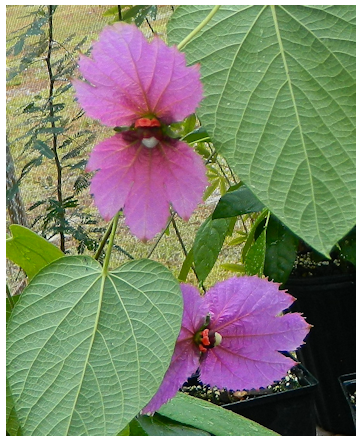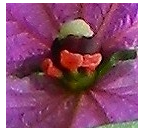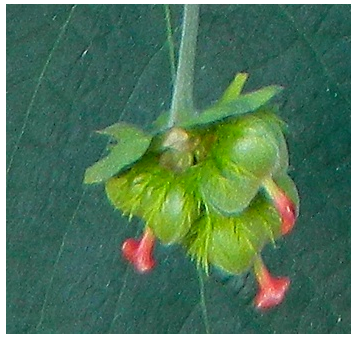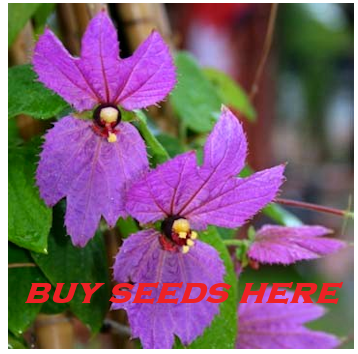Purple Wing Vine
Purple Wing vine, or the Bowtie vine, is one of my favorite plants to keep, as it draws so much attention to itself. Like a beautifully colored parrot surrounded by crows, this plant begs to be noticed. When in full bloom, a multitude of fluorescent purple to lavendar 'flowers' appear along the tendril-less vines, brightly waving in the sun. The Bowtie plant is considered an annual in zones 9 and down, but in zones 10 and up, the vine is evergreen and will flower almost year round.
 Dalechampia dioscoreifolia is from the eurphorbia family, so no wonder I'm drawn to it. There are many fascinating plants in this group, and Purple Wing Vine does not disappoint. A Costa Rican jewel with rich green, heart shaped leaves borne in pairs along the vine. The 'flowers' are actually modified leaves themselves, very similar to the way bouganvillea works up her brightly colored bracts. The actual flower is contained inside these two specialized bracts, and are small, mostly un-noticed whitish yellow with some nectar to guide in the pollinators. It's leaves are used by the larvae of the Gray Cracker Butterfly.
Dalechampia dioscoreifolia is from the eurphorbia family, so no wonder I'm drawn to it. There are many fascinating plants in this group, and Purple Wing Vine does not disappoint. A Costa Rican jewel with rich green, heart shaped leaves borne in pairs along the vine. The 'flowers' are actually modified leaves themselves, very similar to the way bouganvillea works up her brightly colored bracts. The actual flower is contained inside these two specialized bracts, and are small, mostly un-noticed whitish yellow with some nectar to guide in the pollinators. It's leaves are used by the larvae of the Gray Cracker Butterfly.
Because it is in the euphorbia family, some people may be sensitive to the small hairs it presents on the leaves. All parts of the plant are poisonous.
The Bowtie Vine flowers last over a week when the temperatures are mild, and a little less if overly hot, say in the extreme 90's. Rains do not beat them off, and they quickly dry out and point towards the sun. They do wilt quickly if removed from the vine, so do not make good cut flowers for exhibit. Rather, enjoy them attached to the mother plant.
Dalechampia dioscoreifolia, as it is properly known, is an easy vine to keep, and grows very fast. Because it has no tendrils, it will have to be given some kind of support, and initially trained to use that space. A large trellis or a portion of a fence will do. Because it blooms almost year round in a frost free environment, place it so that it gets the most exposure for your viewing. The best show of flowering is spring and summer.
The Purple Wing vine does best in full sun, even down here in the deep south. As long as you keep it moderately watered, the plant will continue to spread and flower throughout the growing seasons. I give mine a loamy soil that is half mixed with the native soil when placing in the ground, up close to a fence. If kept in a container, I just use my standard Brugmansia Soil mix. Be ready to repot it about every 3 months, as it fiercely puts out new, strong roots. break up the bottom third of the rootbal when doing this, and spread the roots out inside the new pot and soil. This will encourage them to spread and fill in new pot faster.
 Water the Bowtie vine moderately, allowing the first inch or so of soil to dry out before rewatering. If it is in the landscape, make sure it is placed where the sprinkler system will get to it 2 or 3 times a week, with a deep watering each time. Do not allow the rootball to completely dry out, the plant will suffer. The plant can neither take a frost, so either dig it up come fall, or keep it in a large pot that can be taken indoors before frost threatens.
Water the Bowtie vine moderately, allowing the first inch or so of soil to dry out before rewatering. If it is in the landscape, make sure it is placed where the sprinkler system will get to it 2 or 3 times a week, with a deep watering each time. Do not allow the rootball to completely dry out, the plant will suffer. The plant can neither take a frost, so either dig it up come fall, or keep it in a large pot that can be taken indoors before frost threatens.
After the up to 5 inch across bracts/flowers fade, if you have had a pollinator such as a bee or butterfly visit several flowers, you will begin to notice small capsules appear in their place. These are seed capsules, and if you wait until the capsules dry on the plant, they are suitable for cracking open and trying your hand at growing a few from seed.
Bowtie Vine is normally an evergreen, but if you've left it outside in too cool temperature range, it will drop it's leaves. This is a warning to bring the plant inside. Overwinter Dalechampia dioscoreifolia in a warm greenhouse or a kitchen, another bright sunny room, and protect from drying out. Inside, aphids or mites may attack. Treat with Neem oil, which is organic and won't irritate the rest of your family. The light lemony fragrance is actually nice.
Purple Wing Vine can become invasive if you live in a frost free climate, so keep this in mind when planting out. It is vigorous, and will eventually take over other vines and nearby plants if left to it's own doings. Clip it back after a strong show of flowers to encourage more growth and flower output. It is easy to train and beautiful to see, so definitely a vine a collector of unusual garden plants would find worthy of a place in their garden.
 It seems the real flower part of dalechampia dioscoreifolia act similar to cherimoya in their reproduction. Over the period of a few days, the flower at first shows the female stigma, and then 2 or 3 days later, the anthers develop. However, then both parts of the flower are then present at the same time. So unlike cherimoya, there may not be a sudden window of opportunity of only hours in which to pollinate, but rather a slow delay in when both male and female parts of one flower are present simultaneously. The center orb is a bit sticky and hard, and suggests that the euglossine bees may be drawn in for this resin-like substance, and accidentally pollenate through the anthers and ovaries on one flower to the pollen on another. Pollinator Bee Reference Material.
It seems the real flower part of dalechampia dioscoreifolia act similar to cherimoya in their reproduction. Over the period of a few days, the flower at first shows the female stigma, and then 2 or 3 days later, the anthers develop. However, then both parts of the flower are then present at the same time. So unlike cherimoya, there may not be a sudden window of opportunity of only hours in which to pollinate, but rather a slow delay in when both male and female parts of one flower are present simultaneously. The center orb is a bit sticky and hard, and suggests that the euglossine bees may be drawn in for this resin-like substance, and accidentally pollenate through the anthers and ovaries on one flower to the pollen on another. Pollinator Bee Reference Material.
The Bowtie vine is easy enough to propagate through semi-hardwood cuttings, or seeds. If you want to save the seeds of the Bowtie vine, it is a good idea to tie an Organza bag, (or a paper bag) over the 3 bulbous pods. These will turn brown as they ripen, and will then burst open, spilling the seeds to the ground unless protected by you. The seeds will germinate in a loamy soil, placed 1/4 inch under the growing medium. Germination is sporadic, and they will need warmth and full sun to come up. Even with fresh seed, it takes mine anywhere between 4 to 8 weeks to come up.
 If you want to try your hand at cuttings, keep them barely moist in a sandy vermiculite mixture or use a Grodan Rock wool cube. Place in a shady spot in your garden for at least 4 weeks. You can also try Stem cutting propagation with water and peroxide method. Seeds propagate in pure moist vermiculite that is placed in full sun. They take anywhere between 4 and 8 weeks to germinate. After gemination, wait until the vines are about 1 foot long before transferring to a soil mix of peat, perlite, vermiculite and compost. Add Osmocote beads to give them all the proper nutrients. Fast growing.
If you want to try your hand at cuttings, keep them barely moist in a sandy vermiculite mixture or use a Grodan Rock wool cube. Place in a shady spot in your garden for at least 4 weeks. You can also try Stem cutting propagation with water and peroxide method. Seeds propagate in pure moist vermiculite that is placed in full sun. They take anywhere between 4 and 8 weeks to germinate. After gemination, wait until the vines are about 1 foot long before transferring to a soil mix of peat, perlite, vermiculite and compost. Add Osmocote beads to give them all the proper nutrients. Fast growing.
Tags: Dalechampia dioscoreifolia, bowtie vine, purple wing vine, dalechampia dioscoreifolia, Dalechampia dioscoreifolia, purple wing vine, grow purple wing vine, how to grow Dalechampia dioscoreifolia,


